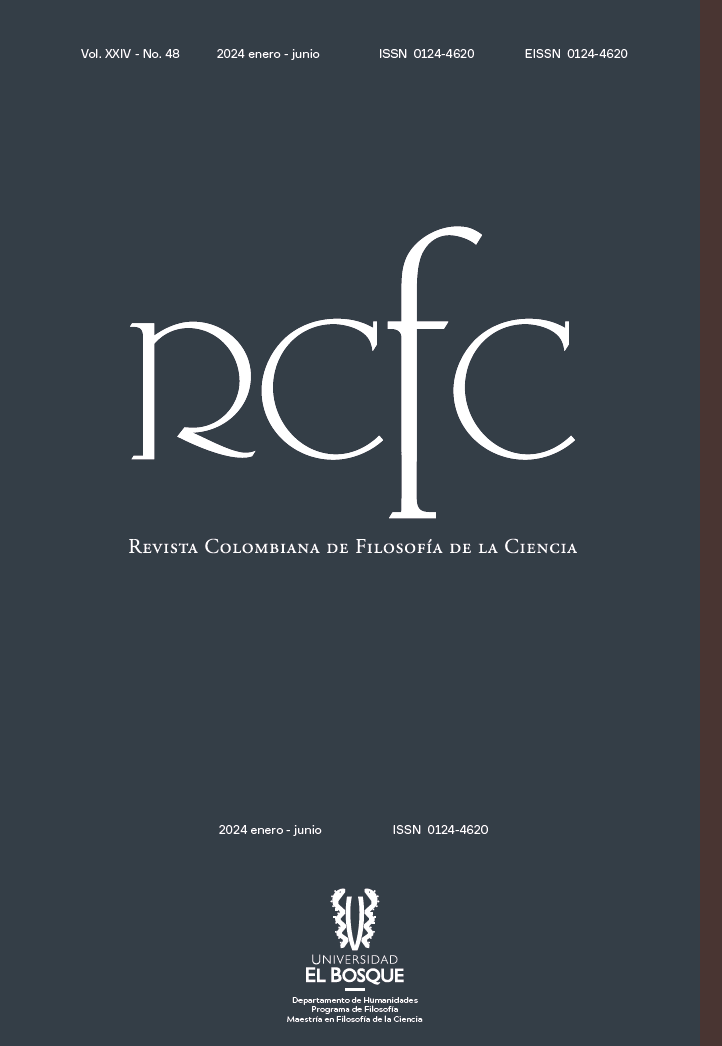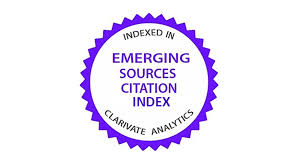El simio egoísta
críticas a la hipótesis del pensamiento maquiavélico
DOI:
https://doi.org/10.18270/rcfc.4414Palabras clave:
cognición animal, cooperación biológica, Tomasello, teoría de la mente, intencionalidad conjuntaResumen
El objetivo de este texto es mostrar que la hipótesis del pensamiento maquiavélico de Tomasello es equivocada. Para ello, presentaré críticas a cuatro puntos fundamentales de esta hipótesis: primero, la afirmación de que los primates no-humanos no pueden atribuir falsas creencias a otros (mindreading o ToM) en contextos cooperativos; segundo, que estos no sienten empatía por individuos fuera de su grupo; tercero, que no tienen sentido de justicia y, por último, que no poseen algún tipo de intencionalidad conjunta. Se concluye que la evidencia científica niega que la cognición de los primates no-humanos haya evolucionado en el contexto de la competencia por la búsqueda de alimentos y que, por ello, su pensamiento sea exclusivamente competitivo e individualista. Por ende, no es posible defender la hipótesis de Tomasello.
Descargas
Referencias bibliográficas
Andrews, Kristen. “Do Apes Attribute Beliefs to Predict Behavior?: A Mengzian Social Intelligence Hypothesis”. The Harvard Review of Philosophy 25.1 (2018): 89-110. < <https://doi.org/10.5840/harvardreview201892117>
____. The Animal Mind: An Introduction to the Philosophy of Animal Cognition. Londres: Routledge, 2020. <https://doi.org/10.4324/9780203712511>
Bader, Oren. “Being in a Group—the Emotional Scaffolding of the Evolution of Collective Intentionality”. Landscapes of Collectivity in the Life Sciences. Eds. Snait B. Gissis, Ehud Lamm y Ayelet Shavit. Londres: The MIT Press, 2018. 155-168.
Bangerter, Adrian., et ál. “Every Product Needs a Process: Unpacking Joint Commitment as a Process Across Species”. Philosophical Transactions of the Royal Society of London 377.1859 (2022): Online. <https://doi.org/10.1098/rstb.2021.0095>
Boesch, Christophe. “What Makes Us Human (Homo Sapiens)? The Challenge of Cognitive Cross-Species Comparison”. Journal of Comparative Psychology 121.3 (2007): 227-240. <https://psycnet.apa.org/doi/10.1037/0735-7036.121.3.227>
____. “Taking Development and Ecology Seriously When Comparing Cognition: Reply to Tomasello and Call (2008)”. Journal of Comparative Psychology 122.4 (2008): 453-455. <https://doi.org/10.1037/0735-7036.122.4.453>
Bräuer, Juliane., Call, Josep., y Tomasello, Michael. “Are Apes Really Inequity Averse?”. Proceedings Biological Sciences 273.1605 (2006): 3123-3128. <https://doi.org/10.1098/rspb.2006.3693>
____. “Chimpanzees Really Know What Others Can See in a Competitive Situation”. Animal Cognition 10.4 (2007): 439-448. <https://doi.org/10.1007/s10071-007-0088-1>
Brosnan, Sarah F. “Nonhuman Species Reactions to Inequity and Their Implications for Fairness”. Social Justice Research 19.1 (2006): 153-185.<https://doi.org/10.1007/PL00022136>
____. “Responses to Inequity in Non-human Primates”. Neuroeconomics: Decision making and the brain. Eds. Paul W. Glimcher, Colin F. Camerer, Ernst Fehr y Russell A. Poldrack. Londres: Elsevier Academic Press, 2009. 285-301. .
____. “A Hypothesis of the Co-evolution of Cooperation and Responses to Inequity”. Frontiers in Neuroscience 5.43 (2011): Online. <https://doi.org/10.3389/fnins.2011.00043>
____. “Comportamientos relacionados con la justicia y la equidad en primates no humanos”. Ludus Vitalis 21.40 (2013): 249-272. <https://www.ludus-vitalis.org/html/textos/40/40-13_brosnan.pdf>
____. “A Comparative Perspective on the Human Sense of Justice”. Evolution and Human Behavior 44.3 (2023): 242-249. <https://doi.org/10.1016/j.evolhumbehav.2022.12.002>
Brosnan, Sarah F., Schiff, Hillary C., y de Waal, Frans B. M. “Tolerance for Inequity May Increase with Social Closeness in Chimpanzees”. Proceedings Biological Sciences 272.1560 (2005): 253-258. <https://doi.org/10.1098/rspb.2004.2947>
Brosnan, Sarah F., Freeman, Cassiopeia., y de Waal, Frans B.M. “Partner’s Behavior, not Reward Distribution, Determines Success in an Unequal Cooperative Task in Capuchin Monkeys”. American Journal of Primatology 68.7 (2006): 713-724. <https://doi.org/10.1002/ajp.20261>
Brosnan, Sarah F., et ál. “Competing Demands of Prosociality and Equity in Monkeys”. Evolution and Human Behavior 31.4 (2010a): 279-288. <https://doi.org/10.1016/j.evolhumbehav.2010.02.003>
____. “Mechanisms Underlying Responses to Inequitable Outcomes in Chimpanzees, Pan Troglodytes”. Animal Behaviour 79.6 (2010b): 1229-1237. <https://doi.org/10.1016/j.anbehav.2010.02.019>
Brosnan, Sarah F y Frans B. de Waal. “Monkeys Reject Unequal Pay”. Nature 425.6955 (2003): 297-299. <https://doi.org/10.1038/nature01963>
____. “Cebus apella Tolerate Intermittent Unreliability in Human Experimenters”. International Journal of Primatology 30.5 (2009): 663-674. <https://doi.org/10.1007/s10764-009-9366-x>
____. “Evolution of Responses to (un)Fairness”. Science 346.6207 (2014): 1251776. <https://doi.org/10.1126/science.1251776>
Buttelmann, David et ál. “Great Apes Distinguish True from False Beliefs in an Interactive Helping Task”. PloS one 12.4 (2017): online. <https://doi.org/10.1371/journal.pone.0173793>
Byrne, Richard W. “Machiavellian Intelligence”. Evolutionary Anthropology 5.5 (1996): 172-180. <https://doi.org/10.1002/(SICI)1520-6505(1996)5:5%3C172::AID-EVAN6%3E3.0.CO;2-H>
Byrne, Richard W. y Andrew Whiten (Eds.). Machiavellian intelligence: Social expertise and the evolution of intellect in monkeys, apes, and humans. Oxford University Press, 1988. <https://api.semanticscholar.org/CorpusID:140446133>
Call, Josep., et ál. “‘Unwilling’ versus ‘unable’: Chimpanzees’ Understanding of Human Intentional Action”. Developmental Science 7.4 (2004): 488-498. <https://doi.org/10.1111/j.1467-7687.2004.00368.x>
Call, Josep y Michael Tomasello. “Does the Chimpanzee Have a Theory of Mind? 30 years Later”. Trends in Cognitive Sciences 12.5 (2008): 187-192. <https://doi.org/10.1016/j.tics.2008.02.010>
Campbell, Matthew W. y Frans B. M. de Waal. “Chimpanzees Empathize with Group Mates and Humans, But not with Baboons or Unfamiliar Chimpanzees”. Proceedings Biological Sciences 281.1782 (2014): Online. <https://doi.org/10.1098/rspb.2014.0013>
Clements, Wendy A. y Josef Perner. “Implicit Understanding of Belief”. Cognitive Development 9.4 (1994): 377-395. <https://doi.org/10.1016/0885-2014(94)90012-4>
de Waal, Frans B. M. “The Chimpanzee’s Sense of Social Regularity and its Relation to the Human Sense of Justice”. American Behavioral Scientist 34.3 (1991): 335-349. <https://doi.org/10.1177/0002764291034003005>
____. “Putting the Altruism Back into Altruism: The Evolution of Empathy”. Annual Review of Psychology 59.1 (2008): 279-300. <https://doi.org/10.1146/annurev.psych.59.103006.093625>
____. El último abrazo. Las emociones animales y lo que nos cuentan de nosotros. Barcelona: Tusquets, 2019.
____. La edad de la empatía. ¿Somos altruistas por naturaleza? Barcelona: Tusquets editores, 2022.
de Waal, Frans B. M. y Stephanie D. Preston. “Mammalian Empathy: Behavioural Manifestations and neural basis”. Nature Reviews. Neuroscience 18.8 (2017): 498-509. <https://doi.org/10.1038/nrn.2017.72>
Dennett, Daniel. “Beliefs about Beliefs”. Behavioral and Brain Sciences 1.4 (1978): 568-570. <https://doi.org/10.1017/S0140525X00076664>
Gavrilets, Sergey y Aaron Vose. “The Dynamics of Machiavellian Intelligence”. Proceedings of the National Academy of Sciences of the United States of America 103.45 (2006): 16823-16828. <https://doi.org/10.1073/pnas.0601428103>
Ghrear, Siba et ál. “Are the Classic False Belief Tasks Cursed? Young Children Are Just as Likely as Older Children to Pass a False Belief Task When They Are Not Required to Overcome the Curse of Knowledge”. PloS one 16.2 (2021): <https://doi.org/10.1371/journal.pone.0244141>
Hare, Brian et ál. “Chimpanzees Know What Conspecifics Do and Do Not See”. Animal Behaviour 59.4 (2000): 771-785. <https://doi.org/10.1006/anbe.1999.1377>
____. “Do Chimpanzees Know What Conspecifics Know?” Animal Behaviour 61.1 (2001): 139-151. <https://doi.org/10.1006/anbe.2000.1518>
Hare, Brian., y Michael Tomasello. “Chimpanzees are More Skilful in Competitive than in Cooperative Tasks”. Animal Behaviour 68.1 (2004): 571-581. <https://doi.org/10.1016/j.anbehav.2003.11.011>
Heesen, Raphaela et ál. “Bonobos Engage in Joint Commitment”. Science Advances 6.51 (2020): <https://doi.org/10.1126/sciadv.abd1306>
____. “Assessing Joint Commitment as a Process in Great Apes”. iScience 24.8 (2021a): <https://doi.org/10.1016/j.isci.2021.102872>
____. “Evidence of Joint Commitment in Great Apes’ Natural Joint Actions”. Royal Society Open Science 8.12 (2021b): Online. <https://doi.org/10.1098/rsos.211121>
Humphrey, Nicholas K. “The Social Function of Intellect”. Growing Points in Ethology. Eds. Patrick P. G. Bateson y Robert A. Hinde. Cambridge University Press, 1976. 303-317. <https://api.semanticscholar.org/CorpusID:17845758>
____. Consciousness Regained: Chapters in the Development of Mind. Oxford University Press, 1983.
Krachun, Carla et ál. “A Competitive Nonverbal False Belief Task for Children and Apes”. Developmental Science 12.4 (2009): 521-535. <https://doi.org/10.1111/j.1467-7687.2008.00793.x>
Krupenye, Christopher et ál. “Great Apes Anticipate that Other Individuals Will Act According to False Beliefs”. Science 354.6308 (2016): 110-114. <https://doi.org/10.1126/science.aaf8110>
Leavens, David A. y Timothy P. Racine. “Joint Attention in Apes and Humans: Are humans Unique?”. Journal of Consciousness Studies 16.6-8 (2009): 240-267. <https://www.ingentaconnect.com/contentone/imp/jcs/2009/00000016/f0030006/art00010>
Pika, Simone y Klaus Zuberbühler. “Social Games Between Bonobos and Humans: Evidence for Shared Intentionality?”. American Journal of Primatology 70.3 (2008): 207-210. <https://doi.org/10.1002/ajp.20469>
Premack, David y Guy Woodruff. “Does the Chimpanzee Have a Theory of Mind?”. Behavioral and Brain Sciences 1.4 (1978): 515-526. <https://doi.org/10.1017/S0140525X00076512>
Preston, Stephanie D. y Frans B. M. de Waal. “Empathy: Its Ultimate and Proximate Bases”. The Behavioral and Brain Sciences 25.1 (2002a): 1-20. <https://doi.org/10.1017/s0140525x02000018>
____. “The Communication of Emotions and the Possibility of Empathy in Animals”. Altruism and Altruistic Love: Science, Philosophy, and Religion in Dialogue. Eds. Stepehn G. Post, Lynn G. Underwood, Jeffrey P. Schloss y William B. Hurlbut. Oxford University Press, 2002b. 284-308. <https://psycnet.apa.org/doi/10.1093/acprof:oso/9780195143584.003.0025>
Sabbatini, Gloria., et ál. “Food Transfers in Capuchin Monkeys: An Experiment on Partner Choice”. Biology Letters 8.5 (2012): 757-759. <https://doi.org/10.1098/rsbl.2012.0534>
Schino, Gabriele y Filippo Aureli. “Reciprocal Altruism in Primates: Partner Choice, Cognition, and Emotions”. Advances in the Study of Behavior 39.1 (2009): 45-69. <https://doi.org/10.1016/S0065-3454(09)39002-6>
____. “Reciprocity in Group-living Animals: Partner Control Versus Partner Choice”. Biological Reviews of the Cambridge Philosophical Society 92.2 (2017): 665-672. <https://doi.org/10.1111/brv.12248>
Scotto, Carolina. “Empatía, antropomorfismo y cognición animal”. Principia: An International Journal of Epistemology 19.3 (2015): 423-452. <https://doi.org/10.5007/1808-1711.2015V19N3P423>
Tokuyama, Nahoko y Takeshi Furuichi. “Do Friends Help Each Other? Patterns of Female Coalition Formation in Wild Bonobos at Wamba”. Animal Behaviour 119.1 (2016): 27-35. <https://doi.org/10.1016/j.anbehav.2016.06.021>
Tokuyama, Nahoko et ál. “Two Wild Female Bonobos Adopted Infants from a Different Social Group at Wamba”. Scientific Reports 11.1 (2021): <https://doi.org/10.1038/s41598-021-83667-2>
Tomasello, Michael. A Natural History of Human Thinking. Harvard University Press, 2014.
____. A Natural History of Human Morality. Harvard University Press, 2016.
____. Becoming Human: A Theory of Ontogeny. Belknap Press of Harvard University Press, 2019.
____. The Evolution of Agency: Behavioral Organization from Lizards to Humans. Cambridge: The MIT Press, 2022.
Tomasello, Michael, y Josep Call. “A Nonverbal False Belief Task: The Performance of Children and Great Apes”. Child Development 70.2 (1999): 381-395. <https://doi.org/10.1111/1467-8624.00028>
____. “Assessing the Validity of Ape-human Comparisons: a Reply to Boesch (2007)”. Journal of Comparative Psychology 122.4 (2008): 449-52. <https://doi.org/10.1037/0735-7036.122.4.453>
Descargas
Publicado
Cómo citar
Número
Sección
Licencia

Esta obra está bajo una licencia internacional Creative Commons Atribución-NoComercial-SinDerivadas 4.0.

| Estadísticas de artículo | |
|---|---|
| Vistas de resúmenes | |
| Vistas de PDF | |
| Descargas de PDF | |
| Vistas de HTML | |
| Otras vistas | |











